Most farriers have a tool kit of specialized tools to use in taking care of horse's hooves. These tools make the job easier, save time, and help keep the horse's hooves properly balanced, healthy and in good condition.
In earlier times, farriers would construct their own tools using the skills acquired at the forge. Few farriers build their own tools today, as modern manufacturing techniques and materials provide better tools at a reasonable price.

Basic farrier tools
Farriers use tools that have evolved over time to quickly and efficiently care for a horse's feet.
© April Raine | EquiDesis
The work of a farrier is hard and dangerous. It takes years of education to properly understand the best methods to trim or fit a shoe to a particular hoof. Done improperly, the horse may sustain injury. Many of the tools mentioned in this article are useful tools in the hands of a farrier, or used under the guidance of a farrier. To learn how to best use these tools for your horse, always work with your farrier to make sure the health of the horse is not compromized.
Basic farrier tools
Hoof tester
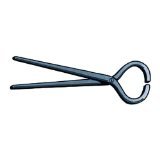 A device used in the examination of the horse's hooves to pinpoint sources of pain by applying pressure in certain areas. This tool is used by the farrier looking for an abscess, or by a veterinarian as part of a standard lameness exam.
A device used in the examination of the horse's hooves to pinpoint sources of pain by applying pressure in certain areas. This tool is used by the farrier looking for an abscess, or by a veterinarian as part of a standard lameness exam.
Care must be taken by the user to reduce the chances of a false positive reading from a sensitive horse.
Farrier's rasp
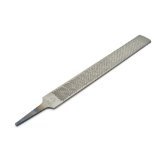 This is a multi-purpose tool that all farriers use. It is like a nail file for horses and enables the farrier to keep the horse's hooves even and level if unshod or lightly rasp any hoof that overhangs a shoe. It is used to finish a trim by rasping off any extra hoof and rounding up the edges. It can also be used to rasp down nails and hoof wall where needed.
This is a multi-purpose tool that all farriers use. It is like a nail file for horses and enables the farrier to keep the horse's hooves even and level if unshod or lightly rasp any hoof that overhangs a shoe. It is used to finish a trim by rasping off any extra hoof and rounding up the edges. It can also be used to rasp down nails and hoof wall where needed.
Recently available are rider's rasps. These are small rasps that can be used by the horse owner to round-off sharp edges that may occur on the trail.
Farrier's knife
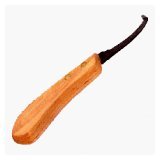 The farrier uses this specialized knife to cut out excess sole and frog in the feet of the horse. Both left-handed and right-handed versions of this knife are available, allowing the farrier to use the appropriate hand depending on the side of the horse he is working on.
The farrier uses this specialized knife to cut out excess sole and frog in the feet of the horse. Both left-handed and right-handed versions of this knife are available, allowing the farrier to use the appropriate hand depending on the side of the horse he is working on.
These knives are very sharp and dangerous to both the farrier and horse if not used properly.
Hoof nippers
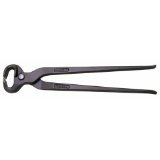 These are used to cut the hoof wall down to the correct length and to cut off any excessive or damaged sole or hoof area to reduce the need for extra rasping. Skilled farriers use hoof nippers to remove not only the overgrown hoof, but also to bevel the edge of the hoof to reduce the amount of rasping that is required. Hoof nippers are also used to trim the frog of the hoof.
These are used to cut the hoof wall down to the correct length and to cut off any excessive or damaged sole or hoof area to reduce the need for extra rasping. Skilled farriers use hoof nippers to remove not only the overgrown hoof, but also to bevel the edge of the hoof to reduce the amount of rasping that is required. Hoof nippers are also used to trim the frog of the hoof.
Because hoof nippers look similar to hoof pullers, the traditional finish of the hoof nipper has straight handle ends while the handle ends of the puller are rounded balls (see below).
Horseshoe pullers
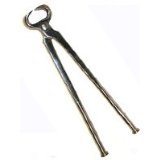 This tool looks like a hoof nipper, but is larger. It is used to pull off the horse's shoe or shoes when necessary. Before using this tool, the farrier will unclinch the nails used a clinching block prior to pulling. This reduces the damage that would otherwise occur in pulling a shoe with the clinches still holding fast.
This tool looks like a hoof nipper, but is larger. It is used to pull off the horse's shoe or shoes when necessary. Before using this tool, the farrier will unclinch the nails used a clinching block prior to pulling. This reduces the damage that would otherwise occur in pulling a shoe with the clinches still holding fast.
Patience is key to pulling a shoe. Work both sides of the shoe branches to gradually loosen the nails. Used incorrectly, pullers can place undue pressure on the horse's sensitive sole and cause pain or bruising.
Anvil
 All farriers need an anvil to mold horse shoes into the proper shape and style needed. Since each horse's hoof is different, the farrier needs to custom fit each shoe by shaping it on the anvil. Another use of the anvil is to make sure that the shoes are absolutely flat. It is very difficult to flatten a shoe without the skill of the farrier and the use of an anvil. If the shoe is not absolutely flat, then it will certainly pull off and may cause pain to the horse.
All farriers need an anvil to mold horse shoes into the proper shape and style needed. Since each horse's hoof is different, the farrier needs to custom fit each shoe by shaping it on the anvil. Another use of the anvil is to make sure that the shoes are absolutely flat. It is very difficult to flatten a shoe without the skill of the farrier and the use of an anvil. If the shoe is not absolutely flat, then it will certainly pull off and may cause pain to the horse.
Farrier's nailing hammer
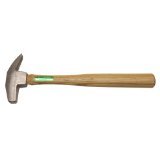 Farrier's Nailing Hammer - A farrier's nailing hammer is a small hammer that is used to punch nails through the horse's hoof to hold the shoe in place. The one side is used to drive the nails and the other side, which has two protruding claws, allows the farrier to "wring off" the nail when it comes out the side of the horse's hoof.
Farrier's Nailing Hammer - A farrier's nailing hammer is a small hammer that is used to punch nails through the horse's hoof to hold the shoe in place. The one side is used to drive the nails and the other side, which has two protruding claws, allows the farrier to "wring off" the nail when it comes out the side of the horse's hoof.
This hammer is surprisingly small. It is important that the farrier obtain a "feel" for the nail as it is driven to make sure the nail emerges at the correct level.
Nail clincher
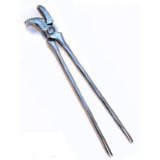 These clinches are used to fold over the nail to make sure the horse shoe stays on the hoof. Two different kinds of clinchers are used. One has a short, ball-like head and the other an "alligator-like" head. Most farriers develop a personal preference for the one that works best for them. Clinching the nails is one of the final steps of shoeing a horse, followed by mostly cosmetic rasping.
These clinches are used to fold over the nail to make sure the horse shoe stays on the hoof. Two different kinds of clinchers are used. One has a short, ball-like head and the other an "alligator-like" head. Most farriers develop a personal preference for the one that works best for them. Clinching the nails is one of the final steps of shoeing a horse, followed by mostly cosmetic rasping.
Nailing or clinching block
 This is usually a small piece of metal with an angled edge. It is put underneath the wrung-off nail when "setting" the nails before clinching. The nailing block is held against the nail clinch while the farrier stricks the nail head to seat it in the shoe. This tool is also used to unclinch a nail prior to pulling the shoe.
This is usually a small piece of metal with an angled edge. It is put underneath the wrung-off nail when "setting" the nails before clinching. The nailing block is held against the nail clinch while the farrier stricks the nail head to seat it in the shoe. This tool is also used to unclinch a nail prior to pulling the shoe.
Hoof stand
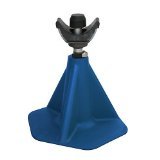 A hoof stand is used for finishing a nailing job and is especially helpful in easing the strain of lifting an injured leg. Hoof stands come in many heights and shapes and each farrier determines which kind works best in their practice. Many farriers to not use a hoof stand, as traditional farrier skills are taught to support the hoof in various ways against the body depending on the operation being performed.
A hoof stand is used for finishing a nailing job and is especially helpful in easing the strain of lifting an injured leg. Hoof stands come in many heights and shapes and each farrier determines which kind works best in their practice. Many farriers to not use a hoof stand, as traditional farrier skills are taught to support the hoof in various ways against the body depending on the operation being performed.
Hoof gauge
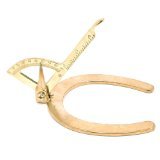 Some farriers use a specialized gauge to measure hoof angles and check the balance of the hoof. This is a relatively new item in the farrier's tool kit and some farrier's prefer to used their eyes and their experience when determining hoof angles and balance. The hoof gauge gives a more precise and objective measurement, and can be used to assure that left and right sides of the horse have similar hoof angles.
Some farriers use a specialized gauge to measure hoof angles and check the balance of the hoof. This is a relatively new item in the farrier's tool kit and some farrier's prefer to used their eyes and their experience when determining hoof angles and balance. The hoof gauge gives a more precise and objective measurement, and can be used to assure that left and right sides of the horse have similar hoof angles.
Horse owner tools

Dressing a trimmed hoof
A properly balanced trimmed hoof aligns the horses pastern bones for proper performance and comfort.
© April Raine | EquiDesis
Many horse owners keep a few basic farrier's tools in their tack boxes for emergency use when a shoe comes loose on the trail or is lost in the pasture, or a need arises for some hoof repair.
Your farrier may be willing to train you in taking basic care of your horse's hooves in an emergency, but be aware that the work is challenging and can be dangerous when it comes to working with large, sometimes cantankerous animals that may bite and kick when they don't like what's going on.
Can you trim or shoe your own horse? Probably not. Professional farriers have undergone rigorous school training to learn hoof structure and proper techniques for care. Most have apprenticed with an experienced mentor. All have handled multiple horses with a large variety of problems. You are far ahead to use an experienced professional in keeping your horses feet in good condition.
Consider this
For the most part, a farrier's skill, and knowledge are your best insurance when it comes to keeping a horse's hooves and lower limbs healthy and properly shod. After all, your horse's soundness largely depends on the health, stability, and balance of its lower limbs and hooves.
